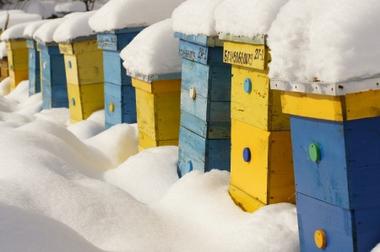Original article by Jim Orem and Ginger Davidson, edited by J. Morgan
What is happening in the hive:
The temperature outside may be freezing but the bees are inside the hive generating heat by pulsating their wing muscles. The bees can disconnect their wings to allow them to use their muscles for heat generation in order to keep the center of the winter cluster at 92 degrees F. Brood rearing and metabolism are starting to increase. This adds moisture to the hive, so make sure lids are water tight, tilt hives so that water drains away, and ensure there is sufficient ventilation. This also means the bees are eating their food stores, so on the warmer days, find the time to go and check their honey or candy board situation.
What a beekeeper should be doing in January:
- In general, try to disturb your bees as little as possible. Learn to access what is happening inside the hives by looking around outside of your hives and within the apiary.
- Look on the ground around the entrance of a hive. Dead bees can actually be a good thing - indicating that live 'undertaker' bees are cleaning up the inside of the hive.
- Keep entrances clear of snow.
- Check entrance reducers and mouse guards if you use them. Mice can chew the openings of wooden reducers large enough to get in. Look for this evidence and cover them with tin or hardware cloth making sure to leave the opening large enough for bees to pull the dead out.
- Check for life by knocking on the hive and listening for the buzz. Don't go crazy though. Get your ear pressed tight against the wall of the hive, then give a quick knock on the opposite side. You should briefly hear all the bees buzz in unison. Don't do too much more as you do not want the bees to come out of their tight cluster.
- Lift the back of the hive to assess its weight and provide emergency feed to featherweight colonies. Those using candy boards can chock some new blocks of pre-hardened sugar in to the top if necessary.
- Make periodic checks of your apiary, especially after a wind storm to make sure the lids are still on, and nothing else is amiss.
- For the non-procrastinators, this is a good time to assemble hive components and repair older equipment while there is not much else to do.
- Order your queens, nucs, and packages now. See our updated local providers page.
- Attend bee club meetings, the February Bee School in Indianapolis or read a bee book.
The beekeeping year is not set in stone. Bees work in tune with nature but a general plan helps to ensure healthy bees and a productive honey crop. It is also advantageous to talk with local beekeepers in order to learn about specific conditions which are indicators triggering the need to complete certain tasks. Beekeeping is as much an art as it is a science. Practice makes perfect. Winter is also a time for reading. Grab a bee book and have it handy for snow days or bedtime reading.



